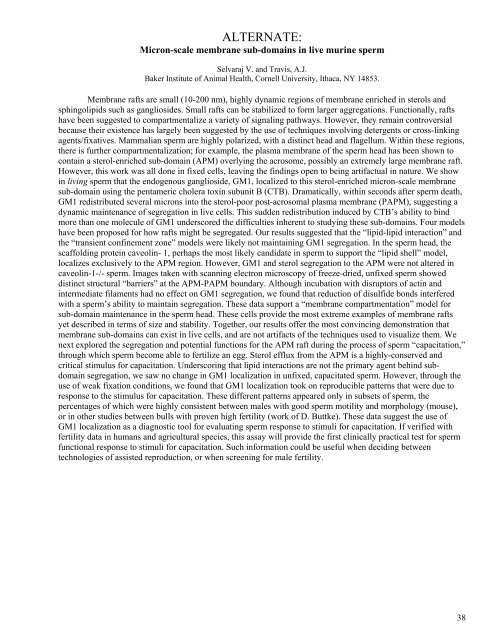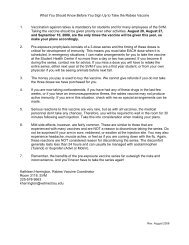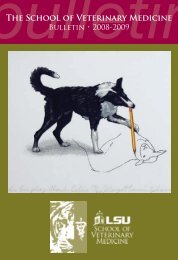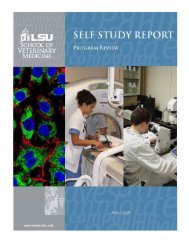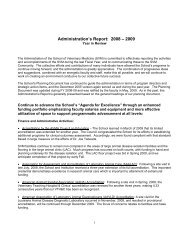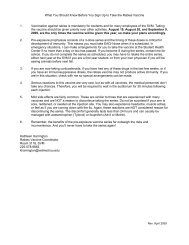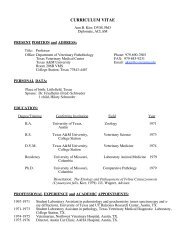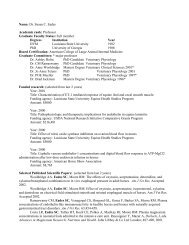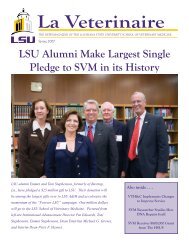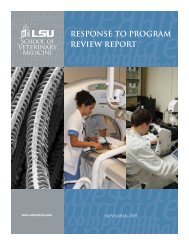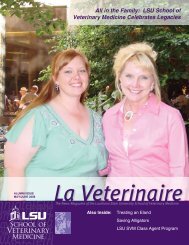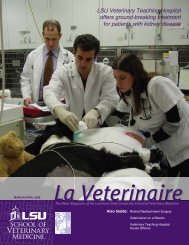2006 merck/merial - School of Veterinary Medicine - Louisiana State ...
2006 merck/merial - School of Veterinary Medicine - Louisiana State ...
2006 merck/merial - School of Veterinary Medicine - Louisiana State ...
You also want an ePaper? Increase the reach of your titles
YUMPU automatically turns print PDFs into web optimized ePapers that Google loves.
ALTERNATE:Micron-scale membrane sub-domains in live murine spermSelvaraj V. and Travis, A.J.Baker Institute <strong>of</strong> Animal Health, Cornell University, Ithaca, NY 14853.Membrane rafts are small (10-200 nm), highly dynamic regions <strong>of</strong> membrane enriched in sterols andsphingolipids such as gangliosides. Small rafts can be stabilized to form larger aggregations. Functionally, raftshave been suggested to compartmentalize a variety <strong>of</strong> signaling pathways. However, they remain controversialbecause their existence has largely been suggested by the use <strong>of</strong> techniques involving detergents or cross-linkingagents/fixatives. Mammalian sperm are highly polarized, with a distinct head and flagellum. Within these regions,there is further compartmentalization; for example, the plasma membrane <strong>of</strong> the sperm head has been shown tocontain a sterol-enriched sub-domain (APM) overlying the acrosome, possibly an extremely large membrane raft.However, this work was all done in fixed cells, leaving the findings open to being artifactual in nature. We showin living sperm that the endogenous ganglioside, GM1, localized to this sterol-enriched micron-scale membranesub-domain using the pentameric cholera toxin subunit B (CTB). Dramatically, within seconds after sperm death,GM1 redistributed several microns into the sterol-poor post-acrosomal plasma membrane (PAPM), suggesting adynamic maintenance <strong>of</strong> segregation in live cells. This sudden redistribution induced by CTB’s ability to bindmore than one molecule <strong>of</strong> GM1 underscored the difficulties inherent to studying these sub-domains. Four modelshave been proposed for how rafts might be segregated. Our results suggested that the “lipid-lipid interaction” andthe “transient confinement zone” models were likely not maintaining GM1 segregation. In the sperm head, thescaffolding protein caveolin- 1, perhaps the most likely candidate in sperm to support the “lipid shell” model,localizes exclusively to the APM region. However, GM1 and sterol segregation to the APM were not altered incaveolin-1-/- sperm. Images taken with scanning electron microscopy <strong>of</strong> freeze-dried, unfixed sperm showeddistinct structural “barriers” at the APM-PAPM boundary. Although incubation with disruptors <strong>of</strong> actin andintermediate filaments had no effect on GM1 segregation, we found that reduction <strong>of</strong> disulfide bonds interferedwith a sperm’s ability to maintain segregation. These data support a “membrane compartmentation” model forsub-domain maintenance in the sperm head. These cells provide the most extreme examples <strong>of</strong> membrane raftsyet described in terms <strong>of</strong> size and stability. Together, our results <strong>of</strong>fer the most convincing demonstration thatmembrane sub-domains can exist in live cells, and are not artifacts <strong>of</strong> the techniques used to visualize them. Wenext explored the segregation and potential functions for the APM raft during the process <strong>of</strong> sperm “capacitation,”through which sperm become able to fertilize an egg. Sterol efflux from the APM is a highly-conserved andcritical stimulus for capacitation. Underscoring that lipid interactions are not the primary agent behind subdomainsegregation, we saw no change in GM1 localization in unfixed, capacitated sperm. However, through theuse <strong>of</strong> weak fixation conditions, we found that GM1 localization took on reproducible patterns that were due toresponse to the stimulus for capacitation. These different patterns appeared only in subsets <strong>of</strong> sperm, thepercentages <strong>of</strong> which were highly consistent between males with good sperm motility and morphology (mouse),or in other studies between bulls with proven high fertility (work <strong>of</strong> D. Buttke). These data suggest the use <strong>of</strong>GM1 localization as a diagnostic tool for evaluating sperm response to stimuli for capacitation. If verified withfertility data in humans and agricultural species, this assay will provide the first clinically practical test for spermfunctional response to stimuli for capacitation. Such information could be useful when deciding betweentechnologies <strong>of</strong> assisted reproduction, or when screening for male fertility.38


